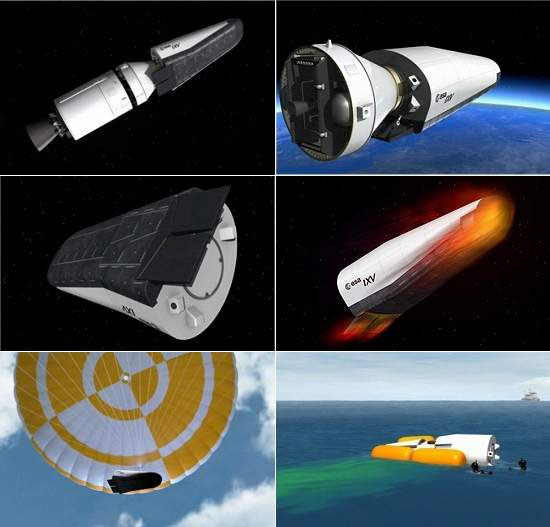Try the artificial meteorite successfully
The European aviation agency is developing a spacecraft that can return to a safe atmosphere, a key technology for missions to conquer space in the future.
Bringing the spacecraft to orbit is difficult, but sometimes bringing it to Earth is even harder. However, the new prototype of Europe's re-used spacecraft is taking another step to the first space mission after overcoming an important test flight in the middle of last week.
According to Space.com, the European Aeronautics Agency (ESA) successfully launched a series of robot engines into orbit, including four cargo ships providing supplies for the International Space Station (ISS). However, these spacecraft are designed to burn pepper when returning to the earth's atmosphere. Now, ESA is developing technology that allows ships to withstand temperatures when they pass through the atmosphere. In the last test flight, the prototype of the intermediate experimental ship (IXV) landed in the sea after being dropped by a helicopter from a height of 3,000m in the Mediterranean airspace, near Sardinia of Italy. When dropped, the device accelerates to reproduce the speed it can truly experience when returning from orbit. Eventually, it parachutes the speed reduction to safely water at 25.2 km / hour. Some people compare IXV to a human-made 'meteorite' that travels through the atmosphere.

Overview of IXV operation - (Photo: ESA)
In a press release about the trial, ESA said it was the last step in a series of experiments showing that IXVs can be safely recovered after implementing the space mission. In the near future, the European agency plans to equip unmanned spacecraft with IXV technology, allowing the withdrawal of vessels after launch. This allows astronauts to send goods back to the ground, such as completed scientific experiments for research, or damaged equipment that needs inspection.
Test flights are a complex combination of steps to ensure safe travel. After the release of the IXV, the two thermal shields surrounded by parachutes and 16 non-explosive propulsion were activated to remove the plates from the bubbles, allowing lightening of the vessel's watering process. . Next, the beacon is turned on, information about the position of the ship and the engineers receive the signal via satellite. IXV continued to hang on the waves until it was safely recovered. Most of the steps above go smoothly, but engineers are examining an unusual point that occurs during the balloon inflating process.
In total, these European testing programs cost about $ 300 million. This is also the first time ESA has implemented such a project. The IXV ships were designed for the same purpose but smaller than the secret US X-37B trajectory testing device. For ease of comparison, IXV ships weigh about 1,800kg and are 4.4m long, 2.2m wide. It is called a 'body lift' due to its shape that allows for lifting effects without wings. To control the flight path, the IXV has propulsion parts and 2 'flaps' that move behind. Meanwhile, X-37B weighs nearly 5,000kg and is about 9m long.
Next year, ESA engineers plan to test IXV from a higher height. Expected, in August 2014, the ship will be taken by Vega missile to the edge of space, 120km from the ground, where it will return to the atmosphere like the case of returning from orbit. This time, IXV technology will have to protect the spacecraft from entering the atmosphere starting at supersonic speeds. From this height, the device will fall at a speed of about 7.5 km / sec. The next stage, called Pride, is scheduled for 2018, with a real orbital flight.
- Successfully developed an artificial arm that can feel real
- Japan successfully launched meteorite probes
- Find the largest meteorite pieces in Russia
- Flocking to find meteorite fragments in Russia
- The meteorite explosions
- A meteorite as big as the Great Pyramid is about to fly over the Earth
- Successfully developing artificial muscles like real ones, being able to reproduce themselves
- Successfully produced artificial milk
- What is Chondrit meteorite?
- The oldest meteorite is about the same age as the Solar System
- Strange meteorite split itself
- Successfully synthesized the world's first artificial DNA molecule
 Van Allen's belt and evidence that the Apollo 11 mission to the Moon was myth
Van Allen's belt and evidence that the Apollo 11 mission to the Moon was myth The levels of civilization in the universe (Kardashev scale)
The levels of civilization in the universe (Kardashev scale) Today Mars, the sun and the Earth are aligned
Today Mars, the sun and the Earth are aligned The Amazon owner announced a secret plan to build a space base for thousands of people
The Amazon owner announced a secret plan to build a space base for thousands of people